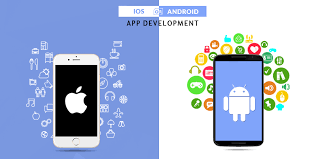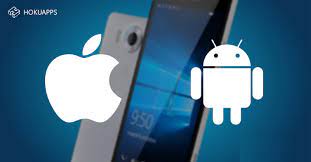Exploring the World of iOS and Android App Development
The World of iOS and Android App Development
Mobile applications have become an integral part of our daily lives, providing convenience, entertainment, and productivity at our fingertips. When it comes to app development, two major platforms dominate the market: iOS and Android.
iOS Development
iOS is the operating system developed by Apple for its mobile devices, including iPhones and iPads. iOS app development requires knowledge of programming languages like Swift or Objective-C. Apple’s strict guidelines ensure high-quality apps that provide a seamless user experience.
Developers working on iOS apps must consider factors such as the intuitive design, smooth performance, and compatibility with various Apple devices. The App Store is the exclusive distribution platform for iOS apps, offering developers a vast audience of potential users.
Android Development
Android, developed by Google, powers a wide range of devices from different manufacturers. Android app development is typically done using Java or Kotlin programming languages. The open-source nature of Android allows for more flexibility in customization and innovation.
Developers creating Android apps focus on scalability across different screen sizes, versions of the operating system, and device capabilities. The Google Play Store serves as the primary marketplace for distributing Android apps to millions of users worldwide.
Key Differences
While both platforms offer unique opportunities for app developers, there are key differences to consider:
- Market Share: Android holds a larger global market share compared to iOS.
- Development Tools: Xcode is used for iOS development, while Android Studio is the preferred IDE for Android.
- Monetization: The App Store tends to generate higher revenue per user compared to the Google Play Store.
- Fragmentation: Android’s fragmentation due to various device types and OS versions can present challenges in app testing and optimization.
The Future of Mobile App Development
As technology continues to evolve, the demand for innovative mobile applications will only grow. Developers skilled in both iOS and Android app development have a competitive edge in creating versatile solutions that cater to diverse user preferences.
Whether you choose to specialize in one platform or master both, staying updated on industry trends and best practices is essential for success in the dynamic world of mobile app development.
Essential FAQs for iOS and Android App Development: Key Differences, Languages, Tools, Optimization, Design, and Monetization
- What are the key differences between iOS and Android app development?
- Which programming languages are commonly used for iOS app development?
- What tools and IDEs are recommended for Android app development?
- How do I optimize my app for both iOS and Android platforms?
- What are the best practices for designing user-friendly interfaces in mobile apps?
- How can I monetize my mobile app effectively on both iOS and Android?
What are the key differences between iOS and Android app development?
When comparing iOS and Android app development, several key differences stand out. One significant distinction is the choice of programming languages, with iOS apps typically being developed using Swift or Objective-C, while Android apps are commonly built using Java or Kotlin. Another crucial factor is the distribution platforms, as iOS apps are exclusively available on the App Store, whereas Android apps can be distributed through the Google Play Store. Additionally, the design guidelines and user experience expectations vary between the two platforms, influencing how developers approach interface design and functionality. Understanding these differences is essential for developers to create successful applications tailored to each platform’s unique requirements and user base.
Which programming languages are commonly used for iOS app development?
When it comes to iOS app development, developers commonly use programming languages like Swift and Objective-C. Swift, introduced by Apple in 2014, has gained popularity for its modern syntax and performance optimization features. Objective-C, the traditional language for iOS development, is still widely used in legacy projects. Both languages offer robust capabilities for creating high-quality iOS applications that deliver a seamless user experience across Apple devices. Understanding these programming languages is essential for developers looking to build innovative and efficient apps for the iOS platform.
What tools and IDEs are recommended for Android app development?
When it comes to Android app development, there are several recommended tools and Integrated Development Environments (IDEs) that can streamline the development process. Android Studio, the official IDE for Android development, is highly recommended for its comprehensive set of features, including code editing, debugging, and performance profiling tools. Other popular tools like IntelliJ IDEA, Eclipse with the Android Development Tools (ADT) plugin, and Visual Studio Code with appropriate extensions can also be used for Android app development. These tools provide developers with a robust environment to create high-quality apps that meet the standards of the ever-evolving Android platform.
How do I optimize my app for both iOS and Android platforms?
Optimizing an app for both iOS and Android platforms requires careful consideration of each platform’s unique characteristics and requirements. To ensure optimal performance and user experience, developers should focus on creating a responsive design that adapts seamlessly to different screen sizes and resolutions. Additionally, optimizing code for efficiency and speed is crucial, as well as conducting thorough testing on various devices to identify and address any compatibility issues. By leveraging platform-specific features and adhering to best practices for iOS and Android development, developers can create high-quality apps that deliver a consistent experience across both platforms.
What are the best practices for designing user-friendly interfaces in mobile apps?
When it comes to designing user-friendly interfaces in mobile apps for iOS and Android platforms, several best practices can significantly enhance the user experience. Firstly, maintaining a clean and intuitive layout with consistent navigation helps users easily understand and interact with the app. Utilizing familiar design patterns specific to each platform, such as iOS Human Interface Guidelines or Android Material Design principles, ensures a seamless experience for users accustomed to the respective operating systems. Prioritizing responsive design for various screen sizes and resolutions, optimizing touch controls for effortless interaction, and providing clear feedback on user actions are essential elements in creating user-friendly interfaces that enhance usability and engagement in mobile apps.
How can I monetize my mobile app effectively on both iOS and Android?
Monetizing a mobile app effectively on both iOS and Android requires a strategic approach tailored to each platform’s unique characteristics. For iOS, developers can leverage in-app purchases, subscriptions, and advertising through Apple’s App Store guidelines. Implementing a freemium model or offering premium features can attract users willing to pay for enhanced functionality. On the Android platform, developers can explore various monetization options such as in-app ads, sponsored content, or selling digital goods. Adhering to Google Play Store policies while optimizing user engagement and retention are crucial for maximizing revenue potential on Android devices. By understanding the monetization opportunities and user behaviors specific to each platform, developers can create sustainable revenue streams for their mobile apps.




